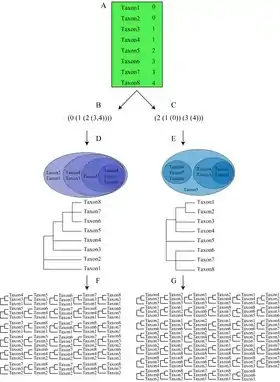
Three-taxon analysis (or TTS, three-item analysis, 3ia) is a cladistic based method of phylogenetic reconstruction. Introduced by Nelson and Platnick in 1991[2] to reconstruct organisms' phylogeny, this method can also be applied to biogeographic areas. It attempts to reconstruct complex phylogenetic trees by breaking the problem down into simpler chunks. Rather than try to resolve the relationships of all X taxa at once, it considers taxa 3 at a time. It is relatively easy to generate three-taxon statements (3is); that is, statements of the form "A and B are more closely related to one another than to C".[3] Once each group of three taxa has been considered, the method constructs a tree that is consistent with as many three-item statements as possible.[3]
From a theoretical point of view, the method has three main problems: (1) character evolution is a priori assumed to be irreversible; (2) 3is that are not logically independent are treated as if they are; (3) 3is that are considered as independent support for a given tree may be mutually exclusive on that tree. [4]
A computer program that implement three-taxon analysis is LisBeth[5] (for systematic and biogeographic studies). LisBeth have been freely released.[6] A recent simulation-based study found that Three-taxon analysis yields good power and an error rate intermediate between parsimony with ordered states and parsimony with unordered states.[1]
See also
References
- 1 2 Grand, Anaïs; Corvez, Adèle; Duque Velez, Lina Maria; Laurin, Michel (2013). "Phylogenetic inference using discrete characters: Performance of ordered and unordered parsimony and of three-item statements". Biological Journal of the Linnean Society. 110 (4): 914–930. doi:10.1111/bij.12159.
- ↑ Nelson, G.; Platnick, N. I. (1991). "Three-Taxon Statements: A More Precise Use of Parsimony?". Cladistics. 7 (4): 351. doi:10.1111/j.1096-0031.1991.tb00044.x. S2CID 86270478.
- 1 2 Zaragueta-Bagils, R.; Bourdon, E. (2007). "Three-item analysis: Hierarchical representation and treatment of missing and inapplicable data". Comptes Rendus Palevol. 6 (6–7): 527. doi:10.1016/j.crpv.2007.09.013.
- ↑ De Laet, J.; Smets, E. (1998). "On the three-taxon approach to parsimony analysis". Cladistics. 14 (4): 363–381. doi:10.1111/j.1096-0031.1998.tb00344.x. PMID 34929915. S2CID 221583681.
- ↑ Bagils, R. Z. E.; Ung, V.; Grand, A. S.; Vignes-Lebbe, R. G.; Cao, N. L.; Ducasse, J. (2012). "LisBeth: New cladistics for phylogenetics and biogeography". Comptes Rendus Palevol. 11 (8): 563. doi:10.1016/j.crpv.2012.07.002.
- ↑ "LisBeth package".